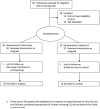Efficacy of SmartLoss, a smartphone-based weight loss intervention: results from a randomized controlled trial
- PMID: 25919921
- PMCID: PMC4414058
- DOI: 10.1002/oby.21063
Efficacy of SmartLoss, a smartphone-based weight loss intervention: results from a randomized controlled trial
Abstract
Objective: Test the efficacy of SmartLoss, a smartphone-based weight loss intervention, in a pilot study.
Design and methods: A 12-week randomized controlled trial. Adults (25 ≤ BMI ≤ 35 kg/m2) were randomized to SmartLoss (n = 20) or an attention-matched Health Education control group (n = 20). SmartLoss participants were prescribed a 1,200 to 1,400 kcal/d diet and were provided with a smartphone, body weight scale, and accelerometer that wirelessly transmitted body weight and step data to a website. In the SmartLoss Group, mathematical models were used to quantify dietary adherence based on body weight and counselors remotely delivered treatment recommendations based on these objective data. The Health Education group received health tips via smartphone. A mixed model determined if change in weight and other endpoints differed between the groups (baseline was a covariate).
Results: The sample was 82.5% female. Mean ± SD baseline age, weight (kg), and BMI were 44.4 ± 11.8 years, 80.3 ± 11.5 kg, and 29.8 ± 2.9 kg/m2, respectively. One participant was lost to follow-up in each group before week 4. Weight loss was significantly (P < 0.001) larger in the SmartLoss (least squares mean ± SEM: -9.4 ± 0.5%) compared with the Health Education group (-0.6 ± 0.5%).
Conclusions: SmartLoss efficaciously promote clinically meaningful weight loss compared with an attention-matched control group. Smartphone-based interventions might prove useful in intervention dissemination.
Trial registration: ClinicalTrials.gov NCT00883350.
© 2015 The Obesity Society.
Figures





References
-
- Jensen MD, Ryan DH, Apovian CM, Ard JD, Comuzzie AG, Donato KA, et al. 2013 AHA/ACC/TOS Guideline for the Management of Overweight and Obesity in Adults: A Report of the American College of Cardiology/American Heart Association Task Force on Practice Guidelines and The Obesity Society. Circulation. 2013 Nov 12; PubMed PMID: 24222017. Epub 2013/11/14. Eng. - PubMed
-
- Wadden TA, Butryn ML, Byrne KJ. Efficacy of lifestyle modification for long-term weight control. Obes Res. 2004 Dec;12(Suppl):151S–62S. PubMed PMID: 15687411. - PubMed
Publication types
MeSH terms
Associated data
Grants and funding
LinkOut - more resources
Full Text Sources
Other Literature Sources
Medical

